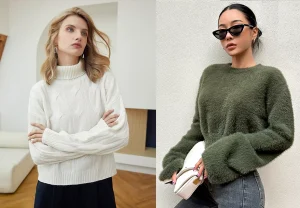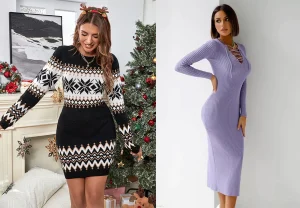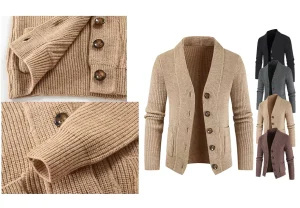Introduction
Knitted suits have become a cornerstone in the fashion industry, seamlessly combining comfort and style to create an apparel category that resonates with modern aesthetics and functional demands. Initially reserved for menswear, the evolution of suits into women’s fashion marked a significant cultural shift. Women’s suits were traditionally associated with structured, formal materials; however, the introduction of knitted fabrics has redefined their use, blending traditional sophistication with contemporary ease.
This article explores the technical progression and creative innovations within the realm of women’s knitted suits, with a particular focus on developments in developed regions such as North America, Europe, and parts of East Asia. The journey of knitted suits from simple, functional pieces to elaborate, fashion-forward statements reflects broader trends in technology, sustainability, and cultural shifts.

Historical Development of Women’s Suits
The journey of women’s suits began in the early 20th century, primarily as a symbol of empowerment and a challenge to traditional gender norms. Originally tailored from rigid, structured materials, these suits were designed to mirror the authority and formality typically reserved for men’s fashion. Coco Chanel, one of the pioneering figures, revolutionized women’s suits in the 1920s with her introduction of the Chanel suit—a softer, more comfortable design that retained elegance and professionalism.
As societal roles for women evolved, so did the design of their suits. By the mid-20th century, women were entering the workforce in unprecedented numbers, necessitating a reevaluation of women’s apparel for both functionality and comfort. It was during this period that knitted materials began to make their mark in women’s fashion, offering flexibility that traditional woven fabrics could not. Designers like Yves Saint Laurent and Armani further pushed the boundaries in the 1960s and 70s by incorporating fine wool and jersey knits into their suit designs, making them more adaptable to the active lifestyles of modern women.
The adaptation of knitted fabrics in women’s suits not only provided comfort but also allowed for more dynamic and form-fitting designs, which accentuated the female form while maintaining professionalism. This marked a significant shift from the boxy silhouettes of the past, aligning more closely with emerging trends that celebrated individual style and freedom of expression.
Materials and Fabrication Techniques
The selection of materials and the techniques used in fabricating women’s knitted suits are central to understanding their appeal and functionality. Traditional suits were often made from wool, tweed, or silk, which, while elegant, offered little in terms of stretch and comfort. The introduction of knitted fabrics brought materials like cashmere, angora, and synthetic blends into the mix, each providing unique benefits such as softness, stretch ability, and durability.
Knitting itself can be performed through various methods, each influencing the texture and quality of the final product. Hand knitting, once a domestic skill, has found its way into high fashion through bespoke and artisanal collections. Meanwhile, machine knitting has evolved significantly with the advent of technology. Modern knitting machines can produce complex patterns and designs that were once only possible with hand knitting, allowing for mass production without sacrificing intricacy.
In the realm of sustainable fashion, developed countries are leading the way in adopting eco-friendly knitting practices. Techniques such as using recycled yarns or organic materials are becoming commonplace, aligning with a global push towards reducing the fashion industry’s environmental footprint. Moreover, the development of biodegradable knit fabrics is paving the way for a new era of eco-conscious fashion, where the lifecycle of a garment is as important as its aesthetic appeal.
These advancements in materials and fabrication not only enhance the quality and appeal of women’s knitted suits but also reflect broader trends in the industry towards sustainability, innovation, and consumer-focused design. As we continue to explore the evolving landscape of women’s fashion, it becomes clear that knitted suits are at the forefront of blending tradition with modernity, providing women with options that are both stylish and sensible.

Design and Aesthetics in Modern Knitted Suits
Modern women’s knitted suits are celebrated for their diverse designs and adaptability to changing fashion trends. The contemporary design ethos for these suits incorporates a blend of classic and innovative elements, allowing them to serve both professional and casual roles seamlessly. The aesthetics of these suits often reflect a minimalist approach, emphasizing clean lines and flattering silhouettes that enhance the wearer’s figure without compromising comfort.
Recent trends in women’s knitted suits have seen an uptick in bold patterns and vibrant colors, deviating from the traditional monochromes of professional wear. This shift is partly influenced by the global fashion scene where cultural fusions bring about new inspirations and design motifs. Designers are increasingly experimenting with various knitting techniques such as ribbing, jacquard, and cable knits to add texture and visual interest to their creations.
Moreover, the integration of technology in design processes, like CAD (Computer-Aided Design) software, has revolutionized the way knitted suits are conceived and executed. These technologies allow designers to visualize and tweak their designs in real-time, ensuring precision and efficiency in the creation of complex patterns and fits tailored to diverse body types.
The Role of Knitted Suits in Professional and Casual Settings
The versatility of women’s knitted suits makes them a staple in both professional and casual wardrobes. In the workplace, these suits offer a polished look while providing comfort and ease of movement, attributes that are particularly appreciated in dynamic work environments. The flexibility of knit fabrics means that these suits can maintain their shape and appearance throughout the day, reducing the need for frequent adjustments or maintenance.
In more casual settings, knitted suits can be styled down with simple accessories and footwear to create a relaxed yet sophisticated look. The popularity of athleisure and the blending of casual wear with formal elements have further elevated the status of knitted suits, making them appropriate for a wide range of social and casual business events.
Consumer preferences in developed regions like North America and Europe show a strong trend towards apparel that combines functionality with style, driving the demand for knitted suits. Women in these areas often seek garments that can transition smoothly from office settings to social gatherings, and knitted suits meet these needs perfectly by adapting to various contexts with ease.
Technological Innovations in Knitted Suit Manufacturing
The production of women’s knitted suits has been significantly enhanced by technological innovations, particularly in the realm of smart textiles and 3D knitting technology. Smart textiles in suits can include features like temperature control, connectivity with devices, and even health monitoring sensors, integrating functionality that extends beyond mere fashion.
3D knitting technology, on the other hand, has been a game-changer in the manufacturing process. It allows for seamless garments to be produced with minimal waste, as the entire suit can be knitted in one complete piece without the need for cutting and sewing different parts. This not only enhances the fit and comfort but also contributes to sustainability by reducing fabric scraps.

The potential for future innovations is vast, with ongoing research in biotechnologies and nanotechnologies promising to introduce even more advanced functionalities in knitted fabrics. These could include self-cleaning suits, UV protection, and enhanced durability, making the next generation of women’s knitted suits smarter and more adaptable than ever before.
The development and integration of these technologies not only push the boundaries of what knitted suits can be but also reflect a broader industry trend towards merging fashion with practical, value-added features. As these innovations continue to evolve, they will undoubtedly shape the future landscape of women’s fashion, making knitted suits an integral part of this forward-looking narrative.
Impact of Cultural and Economic Factors
Cultural and economic factors play pivotal roles in shaping the popularity and evolution of women’s knitted suits in developed regions. Cultural shifts, such as increasing gender fluidity and the casualization of workplace attire, have influenced the design and acceptance of these suits. As societal norms around work and gender expression evolve, so too does the demand for fashion that is both versatile and inclusive. Women’s knitted suits, with their blend of sophistication and comfort, are perfectly positioned to meet these changing cultural expectations.
Economically, the market for women’s knitted suits is influenced by consumer spending habits, the overall economic climate, and the fashion industry’s cyclical nature. In times of economic prosperity, consumers are more likely to invest in higher-quality, versatile pieces like knitted suits. Conversely, during economic downturns, there may be a shift towards more value-oriented purchases, although the demand for durable and multifunctional apparel can remain robust.
Different developed regions exhibit varied dynamics. For instance, in Japan, there is a strong emphasis on meticulous craftsmanship and innovative textiles, which supports a niche market for luxury knitted suits. In contrast, markets like the United States and Europe may focus more on scalability and versatility, catering to a broader audience with varying economic backgrounds.
Challenges and Opportunities
The industry of women’s knitted suits, while growing, faces several challenges. One of the primary concerns is the cost of production, especially when using advanced technologies and high-quality materials. The balance between maintaining affordability and ensuring sustainable practices can be difficult to achieve. Furthermore, the speed of production in the knitting sector is often slower compared to other textile manufacturing methods, posing challenges in meeting fast fashion demands.
However, these challenges also present opportunities. There is a growing niche market for bespoke knitted suits, which allows designers and brands to cater to consumers seeking exclusivity and personalization. Additionally, as consumers become more environmentally conscious, the demand for sustainable and ethically made clothing provides an avenue for growth. Brands that can innovate in eco-friendly practices while maintaining or enhancing the aesthetic and functional qualities of their suits are likely to capture a loyal customer base.

The increasing reliance on e-commerce platforms also offers significant opportunities for reaching a global market. Digital marketing strategies and online retailing can help brands overcome geographical limitations and connect with consumer’s worldwide, offering tailored designs and unique fabric choices more efficiently.
Conclusion
The landscape of women’s knitted suits is characterized by a rich history of innovation, a strong influence of cultural and economic factors, and the continuous evolution driven by technological advancements and shifting consumer preferences. As the market for these garments continues to expand and adapt, the future looks promising with endless possibilities for creativity, sustainability, and technological integration. Women’s knitted suits not only represent a significant segment of the fashion industry but also symbolize the ongoing transformation of apparel to meet the dynamic needs and desires of modern consumers. Contact us now for further information.




